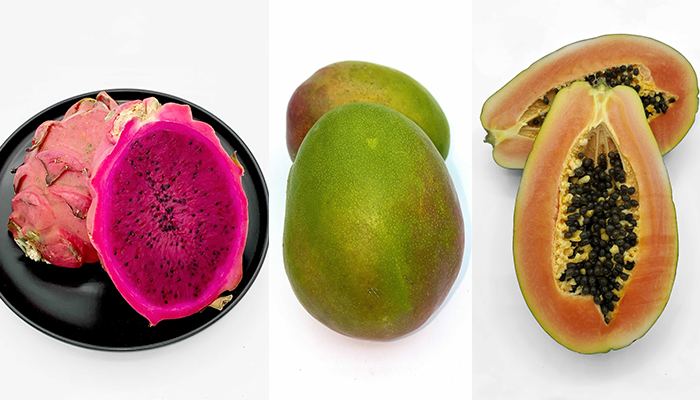Tropical Fruits & Roots to LOVE.

Find the very best in Tropical Roots and Fruits at our Sickles Stores. Each tropical delight is more fascinating than the next! Add some color to your world, along with lots of vitamins, and immune boosting ingredients! Additionally, all these delightful fruits are 20% OFF through the end of February! Stock up on the very, very good stuff.
Plantains: A Very Versatile Fruit!
This close relative of the banana is a Caribbean and Central American favorite, indigenous to tropical regions in Southeast Asia. The term “plantain” is loosely applied to banana varieties that are cooked before eating. Plantains contain more starch and less sugar than dessert bananas, hence why they are usually cooked before eating. There are many sweet and savory culinary applications, like boiling and mashing, slicing and frying (research tostones!), to lightly sugaring and baking. Add a plantain your next meal- you’ll get all the satisfaction of a starchy potato or rice, but with some bonus fiber, potassium, and B & C vitamins!
Papaya: A Large Amber Berry!
The papaya is a small tree with its origin in the tropics of the Americas. Its fruit is a large berry, spherical or cylindrical in form, the skin an amber to orange hue. Along the inside cavity are large black seeds- which are delicious and peppery when blended into a vinaigrette! The flesh is either red or yellow, the red slightly sweeter. Popular preparations include salsas, smoothies, dessert bars. Green unripe papaya is commonly pickled and used in salad, and in some cuisines the young leaves are boiled, or the flower buds sautéed. Peel your papaya, scoop out the seeds and enjoy it raw- or cut it into cubes and freeze for your next smoothie!
Tamarind/Tamarindo – Not just a soda flavor!
Tamarind is a long-lived fruit-bearing tree, indigenous to tropical Africa. The seeds of this fruit contain a sweet, tangy pulp that is used for various applications in cuisines around the world. The whole pod can be used, however the paste and seeds are most often utilized in cooking. Tamarind is delicious and raw, and also makes a great base for BBQ sauces, chutneys, curry sauces, marinades and breads. You may even see it as a Latin agua fresca beverage, diluted with water and sugar. This fruit has medicinal and nutrititious benefits including aiding in digestion, anti-inflammatory properties and high percentage of B-vitamins. To enjoy this fruit, open the pod, discard the outer shell and remove the twig-like veins. Enjoy the seeds and pulp with a distinct tart flavor, and watch out for those tough seeds in the middle
Pineapple – More than a House Under the Sea!
The pineapple is a collective or multiple fruit- in this case, a group of berries that have fused together. A standard cutting method for pineapple is to core and cut it into rounds, then finish with a cherry in the middle of each slice. It is mostly eaten raw or juiced, however this fruit is so versatile you can put it on top of pizza! The health benefits of this spiky friend are numerous, it has a high level of manganese and vitamin C, as well as bromelain enzymes. The Pink Glow pineapple is a blushed variety in which the pink enzyme lycopene has been modified to create a rose-colored flesh. These are very similar in taste to the Honeyglow, the Pinkglow tasting almost candy-like in sweetness (could be a trick of the mind). A tip: If you sniff the base of the fruit and it is very fragrant and sweet-smelling, then it’s probably ready to cut!
Mango – Better than Dessert.
The National Fruit of India in fact- which is the highest mango-producing country. This oval fruit will vary in size, but generally the unripe color will be green, maturing into a yellow-orange when ripe. Their fibrous pit in the middle can make them a challenge to peel and eat- we recommend cutting the sides off as close to the pit as possible, scoring the flesh and scooping it out of the skin. Ripe mangos give off a strong sweet scent when ripe, Aside from their delicious taste and variety of uses, mangos are also full of nutrients like Vitamin A, B6, C and antioxidants, while also being low-calorie. Use your ripe mangos for salsas, smoothies, desserts, chutneys, drinks, or even dried as a snack.
Coconuts – A Fruit, Nut, and Seed All in One!
The coconut is a fruit, nut, and seed, and classified as a drupe (a stone fruit, like the peach). When growing on the tree, it has two outer layers that are removed before going to the market. This leaves the familiar brown, “hairy” layer called the endocarp, which is often thought of as the shell. On the outside are three round indentations, which are called “eyes.” Opening the coconut reveals juice surrounded by a thick layer of white, fibrous meat.
Ginger – King of International Dishes!
Ginger lends its zing to sweet and savory dishes and drinks across a wide range of cuisines. In Caribbean, Indian, and Asian cuisines, fresh ginger root is featured in many meat, seafood, and vegetable dishes. In Western cooking, ground ginger often lends a note of spice to cookies, preserves, and quick breads, along with beverages such as ginger ale and tea. Increasingly, it’s prized for its health benefits, ranging from overall gastrointestinal assistance to antibacterial, antiviral, and anti-inflammatory abilities.
Turmeric – A Vibrant dash of flavor to pump up any dish!
Turmeric is a spice that comes from the root of the turmeric plant. This flowering plant is part of the ginger family and is native to Southeast Asia and the Indian subcontinent. The roots of the plant are used in cooking. The fresh root is oblong and knotty, similar to ginger root. Dried, ground turmeric is a yellow powder that can vary widely from deep yellow-orange to bright yellow, depending on the variety. Turmeric is a typical ingredient in curries and a component of curry powder.
Yucca Root – A Tropical Comfort Fruit! Full of Vitamin C.
Yucca Root is native to Brazil and the tropical areas of the Americas. It’s widely grown all over Latin America and the Caribbean and has been an essential root vegetable in these diets. Since before Columbus’s arrival, cassava has been a staple food of the Taino, Carib, and Arawak population, especially in the form of cassava bread. Because it was so crucial to the culture, Indigenous peoples revered it. Cassava is still eaten throughout the islands today where it is piled high at produce markets. Cassava must be peeled before being used
Persimmons – Silky and Smooth, and Orange in Color!
Persimmons are light to dark orange fruits with a tomato-like stem that grow on trees and are harvested beginning in the late fall. While a native persimmon grows in parts of the United States, the most commonly found persimmons are Asian varieties. Fuyu, a squat, rounded persimmon that resembles an orange tomato, is the most common. The second most popular in America is Hachiya, an acorn-shaped fruit that’s dark orange when ripe. Both have an edible peel that is sometimes removed, and bright orange flesh within.
Dragon Fruit – Sweet, Crunchy, Colorful, and a Superfood!
Dragon fruit, also known as pitaya or the strawberry pear, is a beautiful tropical fruit that is sweet and crunchy. The plant’s fruit comes from a type of cactus of the genus Hylocereus, which includes about 20 different species. Originally popular in Southeast Asia and Latin America, Dragon Fruit is now grown and enjoyed all over the world. Though it may look intimidating with its pinkish red skin and light green scales, preparing this unusual fruit is easy. You can enjoy eating it in fruit salads, it can be used to create tasty drinks and desserts, and it is a wonderful, healthy snack on its own.
